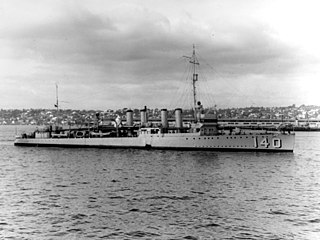
USS Claxton (DD-140), named for Thomas Claxton, was a Wickes-class destroyer in the United States Navy. Entering service in 1919, the destroyer saw intermittent use during the interwar period. During World War II, Claxton was transferred to the Royal Navy and renamed HMS Salisbury. The ship saw service in the Battle of the Atlantic before sold for scrapping in 1944.

The first ship named in honor of Rear Admiral Aaron Ward, USS Aaron Ward (DD-132) was a Wickes-class destroyer in service with the United States Navy. In 1940, she was transferred to the Royal Navy and renamed HMS Castleton.
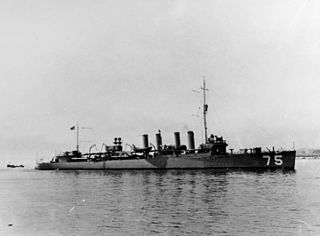
The first USS Wickes (DD-75) was the lead ship of her class of destroyers in the United States Navy during World War I, later transferred to the Royal Navy as HMS Montgomery. She has been the only ship of the Royal Navy to bear the name Montgomery.
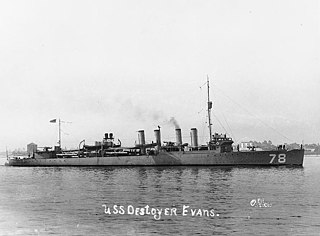
The first USS Evans (DD–78) was a Wickes-class destroyer in the United States Navy during World War I, later transferred to the Royal Navy as HMS Mansfield.

USS Ringgold (DD-89) was a Wickes-class destroyer in the United States Navy during World War I and the interwar period. During World War II, the vessel was transferred to the Royal Navy as a Town-class destroyer named HMS Newark, being scrapped after the end of the war in 1947.

USS Crowninshield (DD–134) was a Wickes-class destroyer in the United States Navy between World War I and World War II. She was named for Benjamin Williams Crowninshield. In World War II she was transferred to the Royal Navy where she was named HMS Chelsea, and subsequently to the Soviet Navy where she was named Derzky.
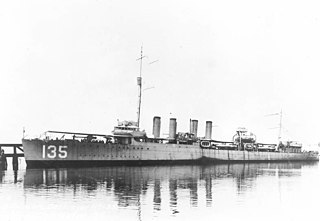
The first USS Tillman (DD–135) was a Wickes-class destroyer in the United States Navy. She was named for Senator Benjamin Tillman. Transferred to the United Kingdom in World War II, she was commissioned in the Royal Navy as HMS Wells.

The first USS Yarnall (DD–143) was a Wickes-class destroyer in the United States Navy during World War I later transferred to the Royal Navy as HMS Lincoln, to the Royal Norwegian Navy as HNoMS Lincoln, and subsequently to the Soviet Navy as Druzhny.

USS Upshur (DD–144) was a Wickes-class destroyer in the United States Navy before and during World War II. She was the first ship named for Rear Admiral John Henry Upshur.
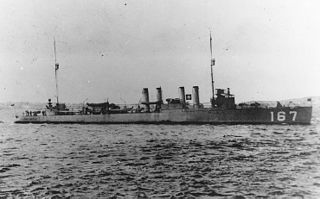
The first USS Cowell (DD–167) was a Wickes-class destroyer in the United States Navy during World War I. She was transferred to the Royal Navy as HMS Brighton, and later to the Soviet Navy as Zharky.

USS Maddox (DD–168) was a Wickes-class destroyer in the United States Navy during World War I. She was later transferred to the Royal Navy as HMS Georgetown (I-40), to the Royal Canadian Navy as HMCS Georgetown, and then to the Soviet Navy as Doblestny . She was the last "four piper" destroyer to be scrapped.

USS Hunt (DD-194) was a Clemson-class destroyer in the United States Navy following World War I. She also served in the United States Coast Guard, as USCGD Hunt (CG-18). She was later transferred to the Royal Navy as HMS Broadway (H90).

USS Welborn C. Wood (DD-195) was a Clemson-class destroyer in the United States Navy during World War II. She served with the United States Coast Guard as USCGD Wood. She was later transferred to the Royal Navy as HMS Chesterfield.

USS Branch (DD-197) was a Clemson-class destroyer in the United States Navy that entered service in 1920. After a short active life, Branch was placed in reserve in 1922. The ship was activated again for World War II before being transferred to the Royal Navy in 1940. Renamed HMS Beverley, the destroyer served in the Battle of the Atlantic as a convoy escort and was torpedoed and sunk on 11 April 1943.
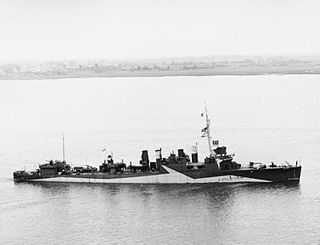
USS Herndon (DD-198) was a Clemson-class destroyer in the United States Navy. Herndon served in the United States Coast Guard as CG-17. She was later transferred to the Royal Navy as HMS Churchill and still later to the Soviet Navy as Deyatelny.
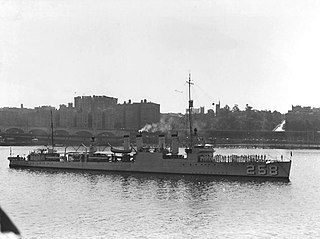
The second USS Aulick (DD-258) was a Clemson-class destroyer in the United States Navy and transferred to the Royal Navy where she served as HMS Burnham (H82) during World War II.

The first USS Laub (DD-263) was a Clemson-class destroyer in the United States Navy and transferred to the Royal Navy where she served as HMS Burwell (H94) during World War II. She was named for Henry Laub.

The first USS McLanahan (DD-264) was a Clemson-class destroyer in the United States Navy and transferred to the Royal Navy where she served as HMS Bradford (H72) during World War II.

USS Edwards (DD-265) was a Clemson-class destroyer in the United States Navy and transferred to the Royal Navy where she served as HMS Buxton (H96) and later in the Royal Canadian Navy during World War II.

HMS Versatile (D32) was an Admiralty V-class destroyer of the British Royal Navy that saw service in World War I, the Russian Civil War, and World War II.





















